| View previous topic :: View next topic |
| Author |
Message |
stevemark

Joined: 29 Apr 2011
Posts: 3773
Location: Switzerland
|
 Posted: Fri Apr 08, 2022 9:16 pm Post subject: Five different Mamiya Sekor 2.8/28mm lenses Posted: Fri Apr 08, 2022 9:16 pm Post subject: Five different Mamiya Sekor 2.8/28mm lenses |
 |
|
stevemark wrote:
Mamiya certainly has a great reputation for its magnificient medium format cameras. However their 35mm SLRs were plagued by ever changing lens mounts and - to some extent - quality control issues, especially with early TL/DTL and late ZE cameras.
Today, a Mamiya Sekor Auto 2.8/28mm did arrive here. It complements my small collection of Mamiya 2.8/28mm lenses. All the lenses shown here have different lens mounts (two are M42, and the three remaining lenses have different bayonet mounts). All these lenses were produced in a time frame of about 15 years - which means on average every three years there was a new lens mount ...
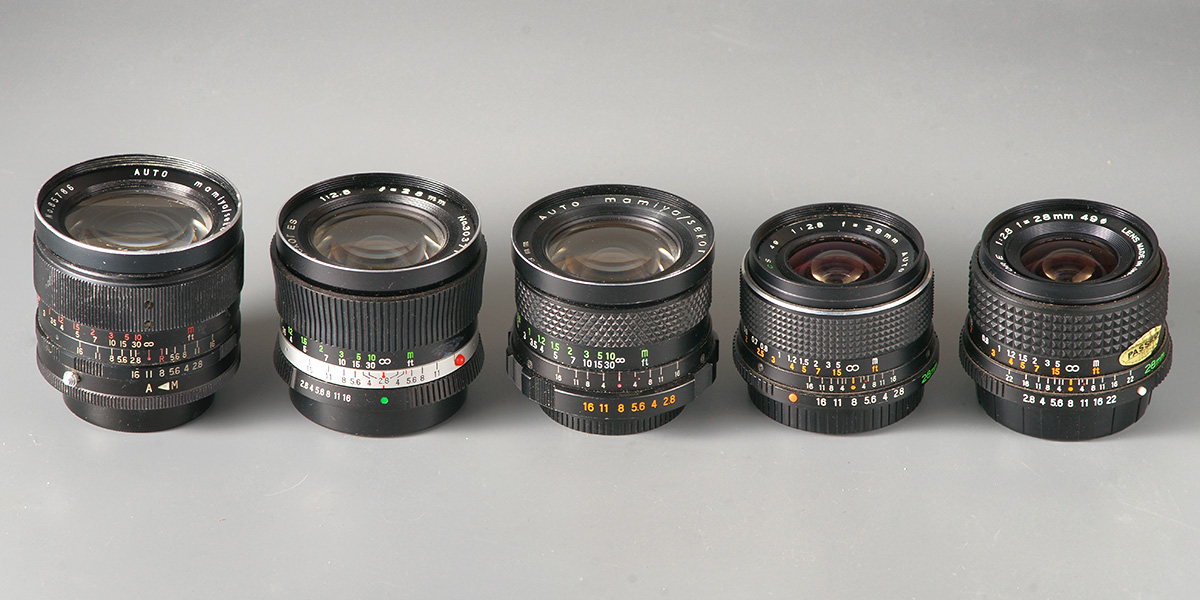 I I
From left to right:
* Auto Mamiya/Sekor 1:2.8 f=28mm (M42 for TL and DTL cameas)
* Auto Mamiya/Sekor ES 1:2.8 f=28mm (large diameter ES bayonet for cameras like XTL and X-1000)
* Auto Mamiya/Sekor SX 1:2.8 f=28mm (M42 with modifications such as lens lockings for precise positioning of the lens)
* Auto Mamiya-Sekor CS 1:2.8 f=28mm (new bayonet for NC-1000 SLRs)
* Mamiya Sekor E 1:2.8 f=28mm (modified bayonet for SLRs like ZE, ZE-2, ZE-X and ZM)
There's also a Mamiya Sekor EF 1:2.8 f=28mm which has additional electronice contacts, optimized for the Mamiya ZE-X (distance coding!)
We have at least three optical computatiuons here -
1) the early Auto Mamiya/Sekro for TL/DTL
2) the Sekor ES and SX
3) the Sekor CS and E (EF)
I will test and compare these versions as soon as possible.
S
_________________
www.artaphot.ch |
|
| Back to top |
|
 |
Alun Thomas

Joined: 20 Aug 2018
Posts: 638
Location: New Zealand
|
 Posted: Fri Apr 08, 2022 9:55 pm Post subject: Posted: Fri Apr 08, 2022 9:55 pm Post subject: |
 |
|
Alun Thomas wrote:
Are the M42 and ES 28mm lenses actually different. I have a Mamiya M42 version 28mm which I am sure is made by Tokina, it is basically the same optically as the T4 Soligor and Vivitar lenses. I also have the 135 and 35mm ES series lenses, and they are also clearly the same as their T4 and Mamiya M42 counterparts, hence my wondering about the 28mm ES mount.
It was said that by the SX series Mamiya was making all their own lenses, but I have not specifically checked that to be true, they do look superficially different.
Edit: looking at your photo, the M42 and ES lenses are different optically, as can be seen by the different positions for the IR marks on the depth of focus scale markings. |
|
| Back to top |
|
 |
iangreenhalgh1


Joined: 18 Mar 2011
Posts: 15679
Expire: 2014-01-07
|
 Posted: Sat Apr 09, 2022 2:49 am Post subject: Posted: Sat Apr 09, 2022 2:49 am Post subject: |
 |
|
iangreenhalgh1 wrote:
I have the SX M42 one, 7 elements, one of the better 28mm lenses of that era.
_________________
I don't care who designed it, who made it or what country it comes from - I just enjoy using it! |
|
| Back to top |
|
 |
caspert79


Joined: 31 Oct 2010
Posts: 2988
Location: The Netherlands
|
 Posted: Sat Apr 09, 2022 6:20 am Post subject: Posted: Sat Apr 09, 2022 6:20 am Post subject: |
 |
|
caspert79 wrote:
I have the E 28/2.8 (or actually the Revuenon rebranded version). It seems to be a solid lens, but have never used or tested it much. |
|
| Back to top |
|
 |
stevemark

Joined: 29 Apr 2011
Posts: 3773
Location: Switzerland
|
 Posted: Sat Apr 09, 2022 6:49 am Post subject: Posted: Sat Apr 09, 2022 6:49 am Post subject: |
 |
|
stevemark wrote:
| Alun Thomas wrote: |
| Are the M42 and ES 28mm lenses actually different. |
The first M42 shown in the picture above (on the very left) certainly is different from the ES. The SX (M42, too) seems to have the same optics as the (earlier) ES. The numerous reflections on the optical glass look identically.
| Alun Thomas wrote: |
I have a Mamiya M42 version 28mm which I am sure is made by Tokina, it is basically the same optically as the T4 Soligor and Vivitar lenses. |
Thanks fro that information - yes, they really look very similar! I didn't realize that before.
| Alun Thomas wrote: |
| I also have the 135 and 35mm ES series lenses, and they are also clearly the same as their T4 and Mamiya M42 counterparts, hence my wondering about the 28mm ES mount. |
On must distinguish between (earlier) Mamiya M42 lenses for the TL/DTL series, an later (post-ES!) Mamiya M42 lenses fro the SX. I'm pretty sure some (most?) of the later M42 lenses (SX) have the same optics as the bayonet mount Mamiya ES lenses, including the 2.8/28mm and the 2.8/135mm.
| Alun Thomas wrote: |
Edit: looking at your photo, the M42 and ES lenses are different optically, as can be seen by the different positions for the IR marks on the depth of focus scale markings. |
Yes, the early M42 (TL/DTL) certainly has not the same optical construction as the later ES and SX lenses.
| iangreenhalgh1 wrote: |
| I have the SX M42 one, 7 elements, one of the better 28mm lenses of that era. |
Yes, that's my impression, too. The SX 2.8/135mm is one of the better vintage 135mm lenses as well, nearly as good as the Zeiss CY Sonnar 2.8/135mm.
| caspert79 wrote: |
| I have the E 28/2.8 (or actually the Revuenon rebranded version). It seems to be a solid lens, but have never used or tested it much. |
I have several copies of the CS 2.8/28mm, and one copy of the Sekor E 2.8/28mm. Both are sophisticated [8/7] constructions, and even though they are really small lenses, my CS 2.8/28mm are excellent performers. My copy of the Sekor E obviously is a "lemon", maybe due to an invisible damage or problems with quality control. I had gotten it from a well known photo dealer who had taken it back from a customer ...
The faster Mamiya Sekor E lenses (2.8/28mm, 1.4/40mm, 2.8/135mm) are extremely rare here in Switzerland, and I haven't been able to find another Sekor E 2.8/28mm to test.
S
_________________
www.artaphot.ch
Last edited by stevemark on Sat Apr 09, 2022 7:36 am; edited 2 times in total |
|
| Back to top |
|
 |
caspert79


Joined: 31 Oct 2010
Posts: 2988
Location: The Netherlands
|
 Posted: Sat Apr 09, 2022 7:27 am Post subject: Posted: Sat Apr 09, 2022 7:27 am Post subject: |
 |
|
caspert79 wrote:
| stevemark wrote: |
| Alun Thomas wrote: |
| Are the M42 and ES 28mm lenses actually different. |
The first M42 shown in the picture above (on the very left) certainly is different from the ES. The SX (M42, too) seems to have the same optics as the (earlier) ES. The numerous reflections on the optical glass look identically.
| Alun Thomas wrote: |
I have a Mamiya M42 version 28mm which I am sure is made by Tokina, it is basically the same optically as the T4 Soligor and Vivitar lenses. |
Thanks fro that information - yes, they really look very similar! I didn't realize that before.
| Alun Thomas wrote: |
| I also have the 135 and 35mm ES series lenses, and they are also clearly the same as their T4 and Mamiya M42 counterparts, hence my wondering about the 28mm ES mount. |
On must distinguish between (earlier) Mamiya M42 lenses for the TL/DTL series, an later (post-ES!) Mamiya M42 lenses fro the SX. I'm pretty sure some (most?) of the later M42 lenses (SX) have the same optics as the bayonet mount Mamiya ES lenses, including the 2.8/28mm and the 2.8/135mm.
| Alun Thomas wrote: |
Edit: looking at your photo, the M42 and ES lenses are different optically, as can be seen by the different positions for the IR marks on the depth of focus scale markings. |
Yes, the early M42 (TL/DTL) certainly has not the same optical construction as the later ES and SX lenses.
| iangreenhalgh1 wrote: |
| I have the SX M42 one, 7 elements, one of the better 28mm lenses of that era. |
Yes, that's my opinion too. The SX 2.8/135mm is one of the better vintage 135mm lenses as well, nearly as good as the Zeiss CY Sonnar 2.8/135mm.
| caspert79 wrote: |
| I have the E 28/2.8 (or actually the Revuenon rebranded version). It seems to be a solid lens, but have never used or tested it much. |
I have several copies of the CS 2.8/28mm, and one copy of the Sekor E 2.8/28mm. Both are sophisticated [8/7] constructions, and even though they are really small lenses, my CS 2.8/28mm are excellent performers. My copy of the Sekor E obviously is a "lemon", maybe due to an invisible damage or problems with quality control. I had gotten it from a well known photo dealer who teken it back from a customer ...
The faster Mamiya Sekor E lenses (2.8/28mm, 1.4/40mm, 2.8/135mm) are extremely rare here in Switzerland, and I haevn't been able to find another Sekor E 2.8/28mm to test.
S |
I suppose that’s up to me then  . Are the optics not exactly the same as the CS? . Are the optics not exactly the same as the CS? |
|
| Back to top |
|
 |
stevemark

Joined: 29 Apr 2011
Posts: 3773
Location: Switzerland
|
 Posted: Sat Apr 09, 2022 7:39 am Post subject: Posted: Sat Apr 09, 2022 7:39 am Post subject: |
 |
|
stevemark wrote:
| caspert79 wrote: |
| stevemark wrote: |
I have several copies of the CS 2.8/28mm, and one copy of the Sekor E 2.8/28mm. Both are sophisticated [8/7] constructions, and even though they are really small lenses, my CS 2.8/28mm are excellent performers. My copy of the Sekor E obviously is a "lemon", maybe due to an invisible damage or problems with quality control. I had gotten it from a well known photo dealer who teken it back from a customer ...
The faster Mamiya Sekor E lenses (2.8/28mm, 1.4/40mm, 2.8/135mm) are extremely rare here in Switzerland, and I haven't been able to find another Sekor E 2.8/28mm to test.
S |
I suppose that’s up to me then  . Are the optics not exactly the same as the CS? . Are the optics not exactly the same as the CS? |
The published lens sections look identical, and so does the shape of the (numerous) reflections on the lens surfaces. Coatings are different though, but that doesn't explain the abysmal performance of my copy of the Sekor E 2.8/28mm.
S
_________________
www.artaphot.ch |
|
| Back to top |
|
 |
Ernst Dinkla

Joined: 30 Nov 2016
Posts: 387
|
 Posted: Sat Apr 09, 2022 10:56 am Post subject: Posted: Sat Apr 09, 2022 10:56 am Post subject: |
 |
|
Ernst Dinkla wrote:
Mamiya Sekor 28mm 2.8 (6/7) TL
Mamiya Sekor 28mm 2.8 (7/7) ES SX Rolleinar MC + Voigtländer
Mamiya Sekor 28mm 2.8 (7/8 ) CS E Rolleinar HFT
Mamiya Sekor 28mm 3.5 (5/5) E
Herron describes the CS 28mm 2.8 version as sharp and with contrast in the center but not so good towards the edges, about average in IQ compared to other brands of that time.
A PP ? review and test of the E 28mm 3.5 is quite favorable despite the 5/5 configuration of that lens. If i recall it correctly Stephan tested some with different results.
TL version

No SX or ES lens diagram in my archive.
CS version
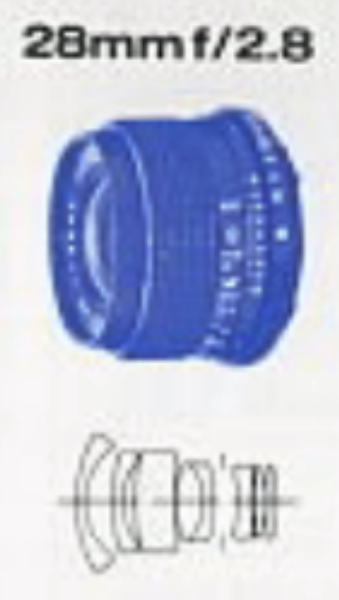
E version

Rolleinar HFT is like the E/CS
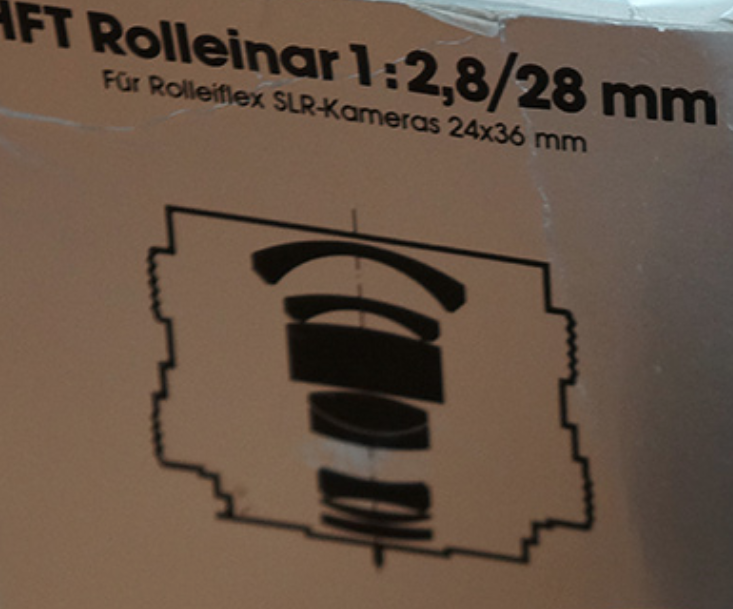
E 3.5 version
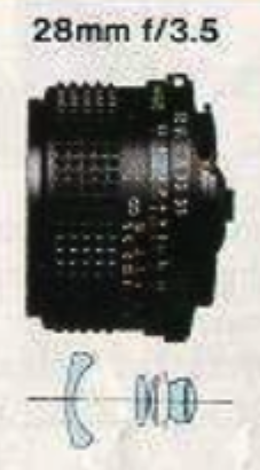  
BTW, there is some similarity between the Mamiya Sekor CS/E/EF 28mm 2.8 and 645 Mamiya C 35mm 3.5 which is more WA of course. An element more roughly in the C design.

_________________
Met vriendelijke groet, Ernst
http://www.pigment-print.com/spectralplots/spectrumviz_1.htm
March 2017 update, 750+ inkjet media white spectral plots |
|
| Back to top |
|
 |
caspert79


Joined: 31 Oct 2010
Posts: 2988
Location: The Netherlands
|
 Posted: Sat Apr 09, 2022 2:15 pm Post subject: Posted: Sat Apr 09, 2022 2:15 pm Post subject: |
 |
|
caspert79 wrote:
Thanks Ernst for posting that. I have an E 28/3.5 as well, that was actually an active Ebay listing, so I just took it off 😊 |
|
| Back to top |
|
 |
D1N0


Joined: 07 Aug 2012
Posts: 2520
|
 Posted: Sat Apr 09, 2022 2:54 pm Post subject: Posted: Sat Apr 09, 2022 2:54 pm Post subject: |
 |
|
D1N0 wrote:
The E looks interesting obviously someone redesigned the older formula with a single front element and a tessar-like rear group but with drastically different elements.

_________________
pentaxian |
|
| Back to top |
|
 |
iangreenhalgh1


Joined: 18 Mar 2011
Posts: 15679
Expire: 2014-01-07
|
 Posted: Sat Apr 09, 2022 6:26 pm Post subject: Posted: Sat Apr 09, 2022 6:26 pm Post subject: |
 |
|
iangreenhalgh1 wrote:
That's a pretty common layout for a five element 28mm, you will find that there are lots of other 28s with a similar layout.
_________________
I don't care who designed it, who made it or what country it comes from - I just enjoy using it! |
|
| Back to top |
|
 |
D1N0


Joined: 07 Aug 2012
Posts: 2520
|
 Posted: Sat Apr 09, 2022 9:06 pm Post subject: Posted: Sat Apr 09, 2022 9:06 pm Post subject: |
 |
|
D1N0 wrote:
| iangreenhalgh1 wrote: |
| That's a pretty common layout for a five element 28mm, you will find that there are lots of other 28s with a similar layout. |
Globally yes but that rear group doesn't look common to me. This the Konica Hexanon AR 28/3.5

_________________
pentaxian |
|
| Back to top |
|
 |
iangreenhalgh1


Joined: 18 Mar 2011
Posts: 15679
Expire: 2014-01-07
|
 Posted: Sat Apr 09, 2022 9:13 pm Post subject: Posted: Sat Apr 09, 2022 9:13 pm Post subject: |
 |
|
iangreenhalgh1 wrote:
I suppose it depends on how far you are prepared to stretch 'similar'.
_________________
I don't care who designed it, who made it or what country it comes from - I just enjoy using it! |
|
| Back to top |
|
 |
caspert79


Joined: 31 Oct 2010
Posts: 2988
Location: The Netherlands
|
 Posted: Sun Apr 10, 2022 6:36 am Post subject: Posted: Sun Apr 10, 2022 6:36 am Post subject: |
 |
|
caspert79 wrote:
| Ernst Dinkla wrote: |

|
How do I have to read this? The article speaks of good, snappy contrast. From the table I conclude however that center contrast is low, but corner contrast is high?
It seems quite even over the frame. |
|
| Back to top |
|
 |
stevemark

Joined: 29 Apr 2011
Posts: 3773
Location: Switzerland
|
 Posted: Sun Apr 10, 2022 9:44 am Post subject: Posted: Sun Apr 10, 2022 9:44 am Post subject: |
 |
|
stevemark wrote:
| caspert79 wrote: |
How do I have to read this? The article speaks of good, snappy contrast. From the table I conclude however that center contrast is low, but corner contrast is high?
It seems quite even over the frame. |
They had defined values for different focal lengths (eg for wideangles, normal lenses, tele-zooms etc) and for "center" and "corner". In other words: The same contrast of xx% might be regarded as "excellent" for the corners of a superwide, but "low" for the center of a normal lens. The exact values were published occasionally, and these value might even have changed over time.
S
_________________
www.artaphot.ch |
|
| Back to top |
|
 |
Ernst Dinkla

Joined: 30 Nov 2016
Posts: 387
|
 Posted: Sun Apr 10, 2022 2:49 pm Post subject: Posted: Sun Apr 10, 2022 2:49 pm Post subject: |
 |
|
Ernst Dinkla wrote:
| D1N0 wrote: |
| iangreenhalgh1 wrote: |
| That's a pretty common layout for a five element 28mm, you will find that there are lots of other 28s with a similar layout. |
Globally yes but that rear group doesn't look common to me. This the Konica Hexanon AR 28/3.5
 |
The early SLR 28mm 3.5 and 2.8 lenses often have the Konica and the Vivitar (below) optical scheme. The Mamiya Sekor E 28mm 3.5 is from a later period but designed with cost reduction in mind. Edit: I see the Konica is actually the last AR version, earlier ones were more complex.
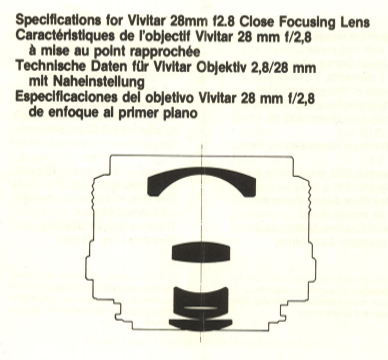
_________________
Met vriendelijke groet, Ernst
http://www.pigment-print.com/spectralplots/spectrumviz_1.htm
March 2017 update, 750+ inkjet media white spectral plots |
|
| Back to top |
|
 |
stevemark

Joined: 29 Apr 2011
Posts: 3773
Location: Switzerland
|
 Posted: Sun Apr 10, 2022 5:06 pm Post subject: Posted: Sun Apr 10, 2022 5:06 pm Post subject: |
 |
|
stevemark wrote:
| iangreenhalgh1 wrote: |
| That's a pretty common layout for a five element 28mm, you will find that there are lots of other 28s with a similar layout. |
In fact, that layout is extremely uncommon for a 1980s retrofocus wideangle.
Nikon's retrofocus Nikkor-H Auto 2.8cm 1:1.3.5 (1960) was the first to have two convex (positive) lenses at the rear of the lens. All previous retrofocus type lenses had either a triplet, a tessar type or a xenotar/planar type master lens - not so the Nikkor-H:
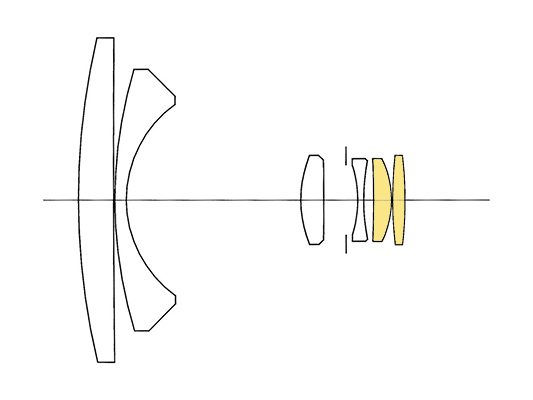
The two positive lenses at the rear (yellow) did drastically reduce coma, which had been the weak point of previous retrofocus designs. This discovery, made by Zenji Wakimoto, was so successful that soon nearly all retrofocus wideangles did have these two positive lenses. Usually they were made of high refractive glass (nD 1.8 and v=25 or v=40). Sometimes one of these lenses was split into a cemented doublet for better color correction (e. g. in the Minolta MC 2.8/21mm and the Minolta AF 2.8/20mm).
I have no idea why Mamiya did not use two rear positive lenses, as by far most other lens makers would have done. The Mamiya Sekor E 3.5/28mm - in spite of what the above test claims! - has a very poor corner performance at f3.5 and f5.6. Stopped down to f11 the image quality is really good, tough.
S
_________________
www.artaphot.ch |
|
| Back to top |
|
 |
iangreenhalgh1


Joined: 18 Mar 2011
Posts: 15679
Expire: 2014-01-07
|
 Posted: Sun Apr 10, 2022 11:54 pm Post subject: Posted: Sun Apr 10, 2022 11:54 pm Post subject: |
 |
|
iangreenhalgh1 wrote:
Nothing extremely uncomon about it.
Better you stick to talking nonsense about extreme corner performance because when you stray away from that, you just make a fool of yourself.
_________________
I don't care who designed it, who made it or what country it comes from - I just enjoy using it! |
|
| Back to top |
|
 |
Alun Thomas

Joined: 20 Aug 2018
Posts: 638
Location: New Zealand
|
 Posted: Mon Apr 11, 2022 12:54 am Post subject: Posted: Mon Apr 11, 2022 12:54 am Post subject: |
 |
|
Alun Thomas wrote:

Interestingly the Mamiya ES 28mm lens appears to come in more than one version. Here is one currently for sale on ebay, which appears to be similar or the same optically as the M42 TL/DTL version, Tokina made. That would explain why my 35mm and 135mm lenses also are identical to Tokina models from that period, perhaps they also changed optically while the XTL/X1000 were the current model. Contemporary accounts had this happening with the introduction of the SX series cameras. |
|
| Back to top |
|
 |
eggplant


Joined: 27 May 2020
Posts: 516
|
 Posted: Mon Apr 11, 2022 1:22 am Post subject: Posted: Mon Apr 11, 2022 1:22 am Post subject: |
 |
|
eggplant wrote:
| stevemark wrote: |
| iangreenhalgh1 wrote: |
| That's a pretty common layout for a five element 28mm, you will find that there are lots of other 28s with a similar layout. |
In fact, that layout is extremely uncommon for a 1980s retrofocus wideangle.
Nikon's retrofocus Nikkor-H Auto 2.8cm 1:1.3.5 (1960) was the first to have two convex (positive) lenses at the rear of the lens. All previous retrofocus type lenses had either a triplet, a tessar type or a xenotar/planar type master lens - not so the Nikkor-H:
The two positive lenses at the rear (yellow) did drastically reduce coma, which had been the weak point of previous retrofocus designs. This discovery, made by Zenji Wakimoto, was so successful that soon nearly all retrofocus wideangles did have these two positive lenses. Usually they were made of high refractive glass (nD 1.8 and v=25 or v=40). Sometimes one of these lenses was split into a cemented doublet for better color correction (e. g. in the Minolta MC 2.8/21mm and the Minolta AF 2.8/20mm).
S |
Curious- was this detail in a Nikon lens tale?
It's also still a triplet at the rear, even with this detail. |
|
| Back to top |
|
 |
D1N0


Joined: 07 Aug 2012
Posts: 2520
|
 Posted: Mon Apr 11, 2022 8:52 am Post subject: Posted: Mon Apr 11, 2022 8:52 am Post subject: |
 |
|
D1N0 wrote:
| iangreenhalgh1 wrote: |
Nothing extremely uncomon about it.
Better you stick to talking nonsense about extreme corner performance because when you stray away from that, you just make a fool of yourself. |
I guess you didn't have your coffee yet.
_________________
pentaxian |
|
| Back to top |
|
 |
|
|
